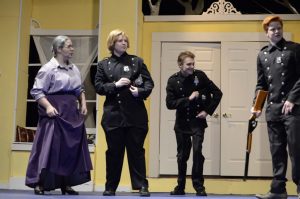 “CHAAAAAAAAARGE!” cried Theodore Roosevelt as he stormed up the notorious San Juan Hill with his band of Rough Riders during the Spanish-American War. This decisive maneuver marked one of the bloodiest battles of the war, but ultimately ended with an American victory, making it one of the most famous battles of the Spanish-American War.
“CHAAAAAAAAARGE!” cried Theodore Roosevelt as he stormed up the notorious San Juan Hill with his band of Rough Riders during the Spanish-American War. This decisive maneuver marked one of the bloodiest battles of the war, but ultimately ended with an American victory, making it one of the most famous battles of the Spanish-American War.
But this isn’t a commemorative documentary on the successes of the American military in foreign wars. The quote taken from Teddy Roosevelt is actually a line from a mentally-ill man, only hallucinating that he is Teddy Roosevelt. This sickly sir is a member of a family of psychotic individuals, except each one is a murderer in his or her own right. So no, this is definitely not a commemorative documentary on the triumph of the America in the Spanish-American War. This is an article commemorating the thematic art created by the Jesuit Stage & Film Department in their performance of Joseph Kesselring’s Arsenic & Old Lace.
On the nights of April 8th, 9th, 15th, and 16th of April in the Jesuit lecture hall, Jesuit Stage & Film put on one of its most memorable productions, performing Joseph Kesselring’s Arsenic & Old Lace.
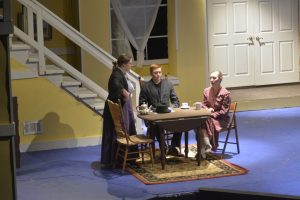 One of the silliest shows to date, the performance revolves around the dynamic Brewster family, a family which we figure out gradually as the show goes, is made up of insane homicidal maniacs. The hero, Mortimer Brewster, a drama critic, is faced with the problem of dealing with his deranged family and the police, as well as deciding whether to go through with his recent promise to marry the woman he loves.
One of the silliest shows to date, the performance revolves around the dynamic Brewster family, a family which we figure out gradually as the show goes, is made up of insane homicidal maniacs. The hero, Mortimer Brewster, a drama critic, is faced with the problem of dealing with his deranged family and the police, as well as deciding whether to go through with his recent promise to marry the woman he loves.
Mortimer has two old aunts, Aunt Abby and Aunt Martha, who lure in lonely old men with their supposed room for rent, eventually murdering the old men with their home-made elderberry wine laced with arsenic, strychnine, and “just a pinch of cyanide,” a key line overheard by Mortimer before he accidentally poisons himself with the virulent vino.
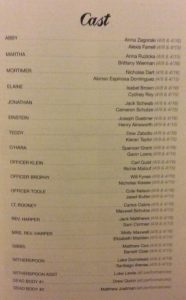 Along with the deranged duo of aunts, Mortimer also has two brothers, both as insane as his aunts, but each in their own special way. One of Mortimer’s brothers, Teddy, believes that he is Theodore Roosevelt, constantly exclaiming, “CHARGE!” as he charges up the stairs, known to him as “San Juan Hill.” The old aunties convince Teddy that more patients have died of “yellow fever” and that they need to be buried alongside the “Panama Canal,” or in reality, their basement.
Along with the deranged duo of aunts, Mortimer also has two brothers, both as insane as his aunts, but each in their own special way. One of Mortimer’s brothers, Teddy, believes that he is Theodore Roosevelt, constantly exclaiming, “CHARGE!” as he charges up the stairs, known to him as “San Juan Hill.” The old aunties convince Teddy that more patients have died of “yellow fever” and that they need to be buried alongside the “Panama Canal,” or in reality, their basement.
Mortimer happens to get sucked into this mess one night when he’s trying to go out on a romantic date with his supposed fiance, Elaine Harper. He has to ask her repeatedly to go home because his family members are murderers, although he doesn’t ever clarify what the reason is for her needing to leave.
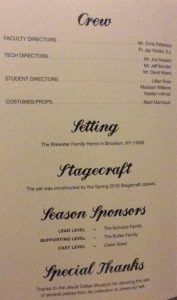 Just as things cannot seem to get any worse, Mortimer’s long lost brother, Jonathan, shows up, but with a different face. Recruiting the help of the drunkard, Dr. Einstein, Jonathan has the doctor alter his face through plastic surgery, as to evade the authorities and not be recognized in public, for he too is a homicidal maniac.
Just as things cannot seem to get any worse, Mortimer’s long lost brother, Jonathan, shows up, but with a different face. Recruiting the help of the drunkard, Dr. Einstein, Jonathan has the doctor alter his face through plastic surgery, as to evade the authorities and not be recognized in public, for he too is a homicidal maniac.
In the end, the whole situation is defused as Jonathan is caught by the police, Teddy and the old aunties are transferred to a facility for the mentally ill, and Mortimer figures out that he actually isn’t a part of the family of murders. He’s a “bastard” child, as he happily states in the final lines of the film.
Since this was the last performance for many of the cast members, many cast members left everything they had out on the floor. Henry Ainsworth ’16 shared his feelings about the show, stating, “Honestly I wasn’t very nervous, I’ve been through this a lot and this is my last Jesuit show so I just went for enjoyment while I was out there rather than getting bogged down in the nerves of it all.” Henry also shared about the uniqueness of this particular play, noting “It was incredible, the show is different from the other shows we’ve done purely because the cast worked so well together that the humor in the script really came through.” Sharing a similar sensation, Alonso Espinosa Domínguez ’16 added, “I felt a mixture of excitement, nervousness, exhaustion, and a ting of sadness since it was my last show.”
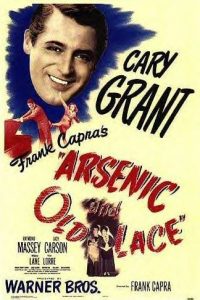 As the last performance for many the cast members, this prompted amazing performances from both seasoned and new members alike, with Alonso remarking, “Cydney R. was amazing, considering it was her first show.” This premier showing inspired more brilliant acting, with Alonso saying once more, “Both aunties in both casts were astounding.They were perhaps best actresses in show.” Cydney R. reflected on her elegant and successful performance with, “This was my first time in theater both at Jesuit and in general. I had no idea what to expect when I went out in front of a big audience, but the thrill of performing and the reactions of the crowd were really amazing and definitely gave me motivation to keep going with theater.”
As the last performance for many the cast members, this prompted amazing performances from both seasoned and new members alike, with Alonso remarking, “Cydney R. was amazing, considering it was her first show.” This premier showing inspired more brilliant acting, with Alonso saying once more, “Both aunties in both casts were astounding.They were perhaps best actresses in show.” Cydney R. reflected on her elegant and successful performance with, “This was my first time in theater both at Jesuit and in general. I had no idea what to expect when I went out in front of a big audience, but the thrill of performing and the reactions of the crowd were really amazing and definitely gave me motivation to keep going with theater.”
Overall, this was the best show I’ve ever scene, pure comedic “Gold” you could say. Come out to the next play to see truly amazing acting from the Jesuit Stage & Film in the future!






